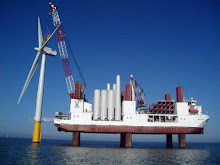Sabtu, 17 Oktober 2009
Jumat, 12 Juni 2009
Air minum dari embun

Drinking Water From Air Humidity
ScienceDaily (June 8, 2009) — Not a plant to be seen, the desert ground is too dry. But the air contains water, and research scientists have found a way of obtaining drinking water from air humidity. The system is based completely on renewable energy and is therefore autonomous.
Cracks permeate the dried-out desert ground, the landscape bears testimony to the lack of water. But even here, where there are no lakes, rivers or groundwater, considerable quantities of water are stored in the air. In the Negev desert in Israel, for example, annual average relative air humidity is 64 percent – in every cubic meter of air there are 11.5 milliliters of water.
Research scientists at the Fraunhofer Institute for Interfacial Engineering and Biotechnology IGB in Stuttgart working in conjunction with their colleagues from the company Logos Innovationen have found a way of converting this air humidity autonomously and decentrally into drinkable water. “The process we have developed is based exclusively on renewable energy sources such as thermal solar collectors and photovoltaic cells, which makes this method completely energy-autonomous. It will therefore function in regions where there is no electrical infrastructure,” says Siegfried Egner, head of department at the IGB. The principle of the process is as follows: hygroscopic brine – saline solution which absorbs moisture – runs down a tower-shaped unit and absorbs water from the air. It is then sucked into a tank a few meters off the ground in which a vacuum prevails. Energy from solar collectors heats up the brine, which is diluted by the water it has absorbed.
Because of the vacuum, the boiling point of the liquid is lower than it would be under normal atmospheric pressure. This effect is known from the mountains: as the atmospheric pressure there is lower than in the valley, water boils at temperatures distinctly below 100 degrees Celsius. The evaporated, non-saline water is condensed and runs down through a completely filled tube in a controlled manner. The gravity of this water column continuously produces the vacuum and so a vacuum pump is not needed. The reconcentrated brine runs down the tower surface again to absorb moisture from the air.
“The concept is suitable for various sizes of installation. Single-person units and plants supplying water to entire hotels are conceivable,” says Egner. Prototypes have been built for both system components – air moisture absorption and vacuum evaporation – and the research scientists have already tested their interplay on a laboratory scale. In a further step the researchers intend to develop a demonstration facility.Recycling Wind Turbines

Recycling Wind Turbines
ScienceDaily (Sep. 23, 2007) — The development of wind power promises much in terms of providing us with renewable energy for the future and wind turbines could be the most effective way to harness that power.
Danish researchers now suggest that in order to assess the overall environmental impact of wind power, however, the finite lifespan of wind turbines and the need to replace and recycle them must be taken into account. Such an assessment will help policy makers and the industry to develop the green credentials of wind power more effectively.
Writing recently in the Inderscience publication, International Journal of Technology, Policy and Management, the researchers describe a prospective case study for managing environmental aspects of wind turbines. Their suggested plan for assessing the overall impact of installing and operating wind turbines should be adopted by the industry and policy makers, they say.
Wind turbines are one of the most environmentally sound technologies for producing electricity, explain the researchers. However, the removal and recycling phase of wind turbines has been identified as a blind spot in assessing their overall environmental impact. Most studies have ignored this phase and focused entirely on their operation and in some cases the production and installation of wind turbines.
Foresight and innovation analysts Per Dannemand Andersen and Mads Borup working with wind energy expert Thomas Krogh have devised a method for mapping and mitigating the negative environmental impacts of wind turbines which considers the future removal and recycling of offshore wind turbines up to the year 2050. By combining life-cycle assessment and taking into account future developments in this area of renewable energy, the team hopes that the wind power industry will be able to minimize any potential negative impact of their use.
"Because the wind-turbine industry is relatively young, there is only a limited amount of practical experience on the removal and recycling of wind turbines," Dannemand Andersen says, "It is likely to take more than 20 years before a substantial amount of practical experience regarding the dismantling, separation, recycling, disposal, etc., of wind-power systems is gained."
The present study has developed an interactive and process-oriented method for investigating the environmental impact of wind turbines removal and recycling. The team hopes that the industry will adopt their approach and so find ways to reduce any negative impacts of wind power.
